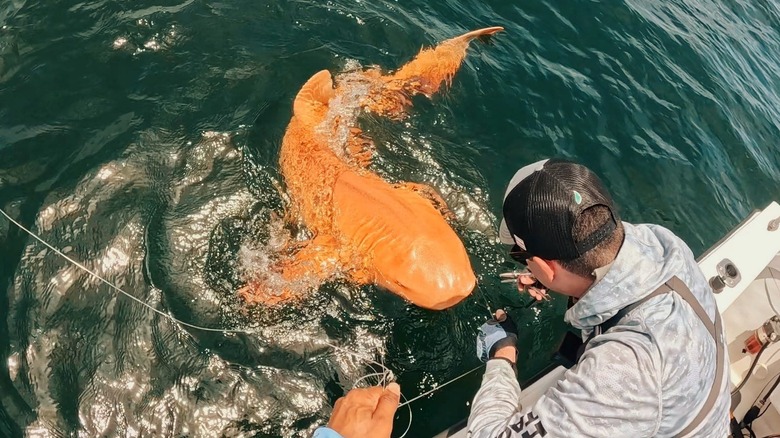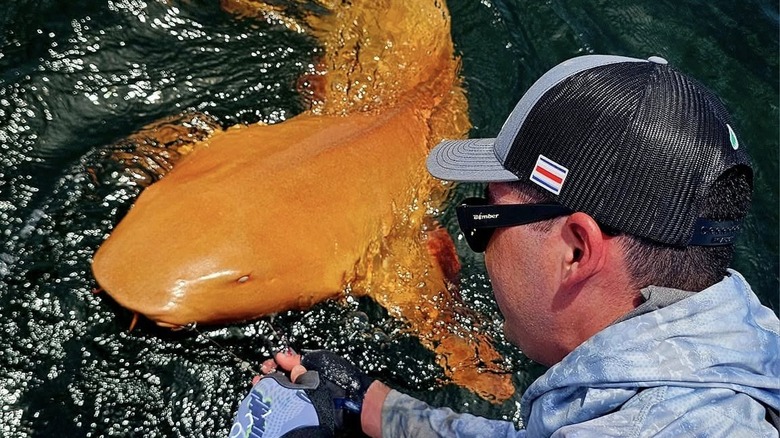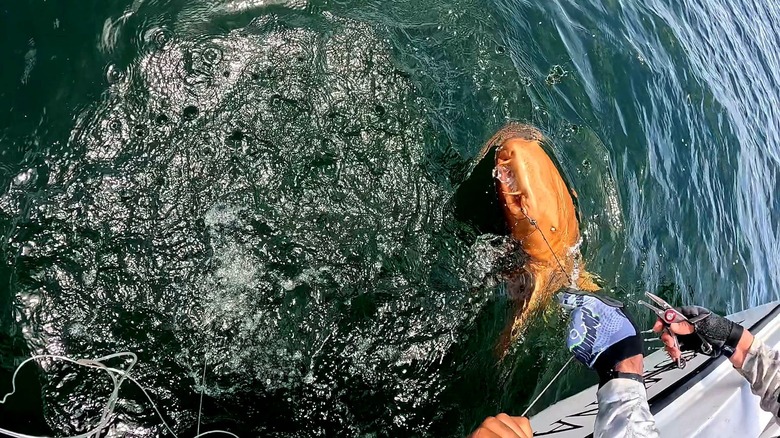The World's First Orange Shark Is The Result Of Two Rare Conditions
Sport fishers caught the one-of-a-kind nurse shark (Ginglymostoma cirratum) off the east coast of Costa Rica back in 2024. Not only was its skin a vibrant orange, its eyes were hauntingly white, making this 6.6-foot-long fish — which the fishermen released back into the ocean — an utterly unique discovery. Since scientists weren't able to inspect the live shark, it's impossible to know precisely why its skin was orange, but it's suspected that a set of unique genetic combinations are the primary culprit — xanthochromism and albinism.
Much like the incredible rare orange alligators of central Africa, this unusual nurse shark was a complete surprise to not only the fishers who caught it, but to experts who had never encountered such a thing in the wild. Researchers published their analysis of the nurse shark photos in a study published in the journal Marine Biodiversity, where they explained that the highly unusual skin color was due to a condition known as xanthochromism, or xanthism, a condition where the skin appears yellowish due to an absence of darker pigments. This particular nurse shark is also thought to have had another condition which causes a lack of pigment production — albinism.
Xanthochromism is virtually unheard of in shark species
Xanthochromism is very rare in marine species in general. This specific nurse shark is not only the first scientifically documented case of total xanthism in the species, but the first ever example of a cartilaginous fish found with the condition in the Caribbean. In 2021, fish were discovered with the condition in the Arabian Sea, and in 2024, scientists documented the first ever common snook (also known as the sergeant fish) with xanthochromism.
There have also been several birds discovered with the skin condition. But this being the first ever nurse shark (which thankfully isn't yet on the list of endangered shark species) to exhibit the condition makes it a truly unique discovery.
Due to the fact the creature had white eyes instead of the typical black associated with the species, researchers believe it is likely to have been an albino nurse shark. This condition, much more common than xanthism in fish, results in little to no production of the skin pigment called melanin, the lack of which can give creatures white hair, skin, and eyes. In this case, the combination of the two conditions resulted in one of the most unique looking animals yet recorded.
Scientists don't know if genetics or environmental stress is the root cause
Nurse sharks are already unique in that they don't share the grey coloration of most shark species. Instead, they have a yellowish-brown hue and can even be dark brown. But as the researchers who conducted the Marine Biodiversity study noted, since the orange nurse shark appeared to be fully grown, its combination of xanthism and albinism seemed unlikely to hinder the survival of the species. That's significant not only because animals typically evolve with specific colors which help them survive in their environments, but because it increases the likelihood that, if there are more nurse sharks with this unique appearance in the Caribbean Sea, they might well have survived and could be studied in the future.
Though xanthochromism is thought to be genetic, the study notes that there could be other factors at play with this particular nurse shark. Environmental stress and elevated temperatures could have played a role, while the researchers also note that inbreeding and hormonal imbalances might also explain the unique look of this particular specimen. The study authors point out that further research is needed to identify the exact reasons why this nurse shark exhibits such a rare pigmentation.


